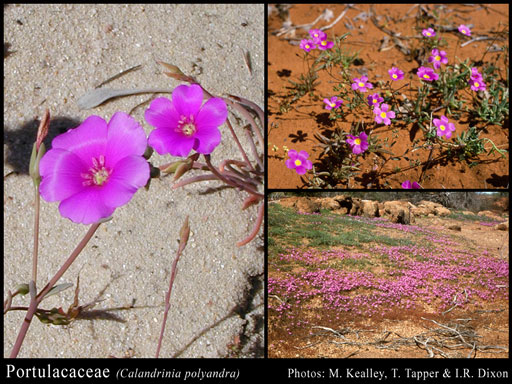- Reference
- Gen.Pl. [Jussieu] 312 (1789)
- Name Status
- Current

Scientific Description
Common name. Portulaca Family.
Habit and leaf form. Shrubs and herbs. Plants succulent (often), or non-succulent. Helophytic to xerophytic. Leaves alternate, or opposite; when alternate, spiral; fleshy (often), or ‘herbaceous’; petiolate to sessile; non-sheathing; simple. Leaf blades entire; linear, or lanceolate, or oblanceolate, or ovate, or obovate; pinnately veined, or one-veined; cross-venulate. Leaves with stipules, or without stipules (Claytonia). Stipules intrapetiolar; scaly (or sometimes represented by axillary hairs). Leaf blade margins entire. Leaves without a persistent basal meristem. Stem anatomy. Nodes unilacunar. Secondary thickening absent, or developing from a conventional cambial ring.
Reproductive type, pollination. Fertile flowers hermaphrodite. Unisexual flowers absent. Plants hermaphrodite. Entomophilous.
Inflorescence and flower features. Flowers solitary, or aggregated in ‘inflorescences’; in cymes. The terminal inflorescence unit cymose. Inflorescences usually cymes, often dichasial or tending to cincinni. Flowers bracteolate (if the ‘sepals’ are interpreted as bracteoles); small, or medium-sized; regular to somewhat irregular; cyclic; tetracyclic. Free hypanthium present to absent. Hypogynous disk present. Perianth with distinct calyx and corolla, or sepaline (the latter if the ostensible ‘calyx’ is interpreted as ‘bracteoles’, whereupon the ‘corolla’ becomes a petaloid calyx); 7; 2–3 -whorled; anisomerous. Calyx 2; 1–2 -whorled; polysepalous, or gamosepalous (the members sometimes united basally); imbricate (the upper member overlapped); persistent. Corolla (if not interpreted as calyx) (2–)5(–18); 1 -whorled; polypetalous, or gamopetalous (sometimes basally connate); imbricate; regular; white, or yellow, or pink, or purple (often satiny). Androecium 5, or 10, or 4–100 (i.e. to ‘many’). Androecial members branched (bundled, when ‘many’), or unbranched; free of the perianth, or adnate (to the corolla base); free of one another, or coherent; when coherent 1 - adelphous, or 2–7 - adelphous; 1 -whorled, or 2 -whorled. Androecium exclusively of fertile stamens. Stamens 3, or 4, or 5, or 10, or 6–50; isomerous with the perianth, or diplostemonous to polystemonous; when 5, alternisepalous (opposite the petals). Anthers dehiscing via longitudinal slits; introrse; tetrasporangiate. Gynoecium (2–)3(–9) carpelled. The pistil 1 celled. Carpels reduced in number relative to the perianth. Gynoecium syncarpous; synovarious, or synstylovarious; superior, or partly inferior (Portulaca). Ovary unilocular; 1 locular. Styles 1, or 3(–9); apical. Stigmas dry type; papillate; Group II type. Placentation basal, or free central. Ovules in the single cavity 2–100 (to ‘many’); anatropous to amphitropous.
Fruit and seed features. Fruit non-fleshy; dehiscent (usually), or indehiscent; a capsule, or capsular-indehiscent. Capsules circumscissile, or valvular. Fruit elastically dehiscent (sometimes), or passively dehiscent. Seeds non-endospermic. Perisperm present. Seeds with starch. Embryo well differentiated. Cotyledons 2(–4). Embryo achlorophyllous (2 species of Portulaca); curved. Seedling. Germination phanerocotylar.
Physiology, biochemistry. Plants often accumulating free oxalates. Photosynthetic pathway: C4 and CAM (and C4/CAM intermediates?).
Geography, cytology, number of species. World distribution: cosmopolitan, except for frigid zones. X = 4–42 (or more). 580 species.
Economic uses, etc. A few cultivated ornamentals (Portulaca grandiflora, Talinum, Lewisia and Calandrina spp.), and Portulaca oleracea constitutes a potherb and salad green.